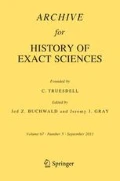Abstract
In 1751, LEONHARD EULER established “harmony” between two principles that had been stated by PIERRE-LOUIS-MOREAU DE MAUPERTUIS a few years earlier. These principles are intended to be the foundations of Mechanics; they are the principle of rest and the principle of least action.
My claim is that the way in which “harmony” is achieved sets the foundations of so called Analytical Mechanics: it discloses the physical bases of the general ideas, concepts, and motivations of the formalism. My paper intends to show what those physical bases are, and how a picture of the formalism issues from them. This picture is shown to be recast in JOSEPH-LOUIS LAGRANGES justification of the formalism, which strengthens my claim.
Similar content being viewed by others
Author information
Authors and Affiliations
Additional information
(Received December 30, 1998)
Rights and permissions
About this article
Cite this article
Cardoso Dias, P. Eulers “Harmony” Between the Principles of “Rest” and “Least Action”. Arch Hist Exact Sc. 54, 67–86 (1999). https://doi.org/10.1007/s004070050034
Issue Date:
DOI: https://doi.org/10.1007/s004070050034




